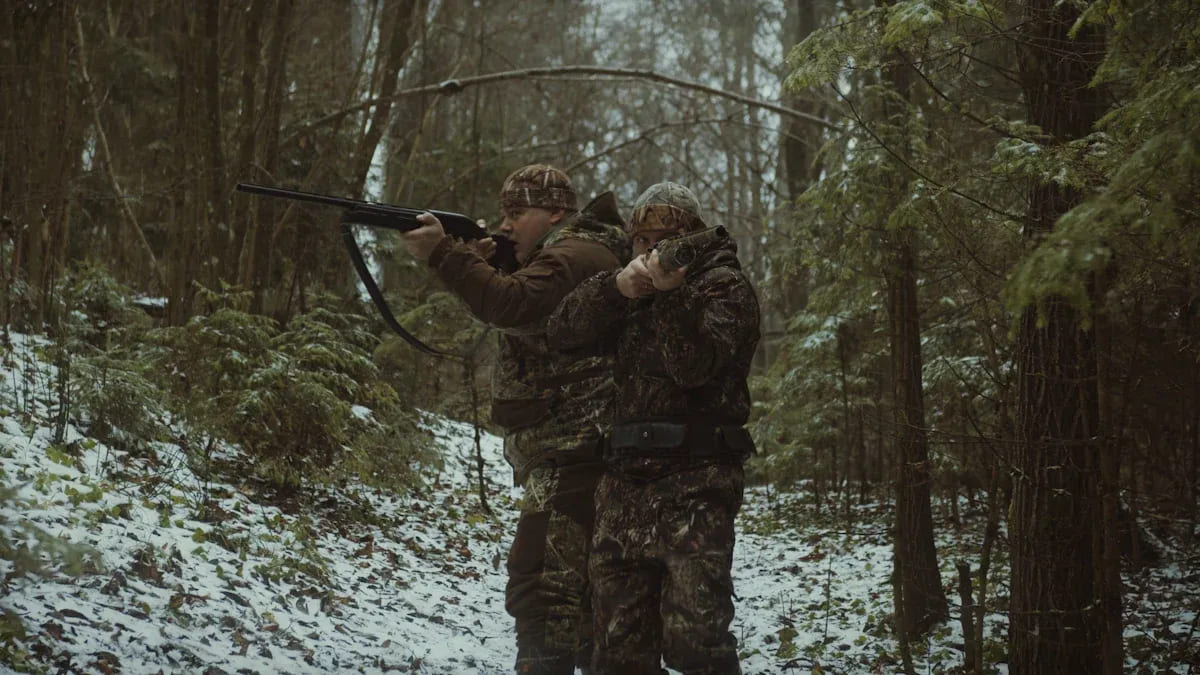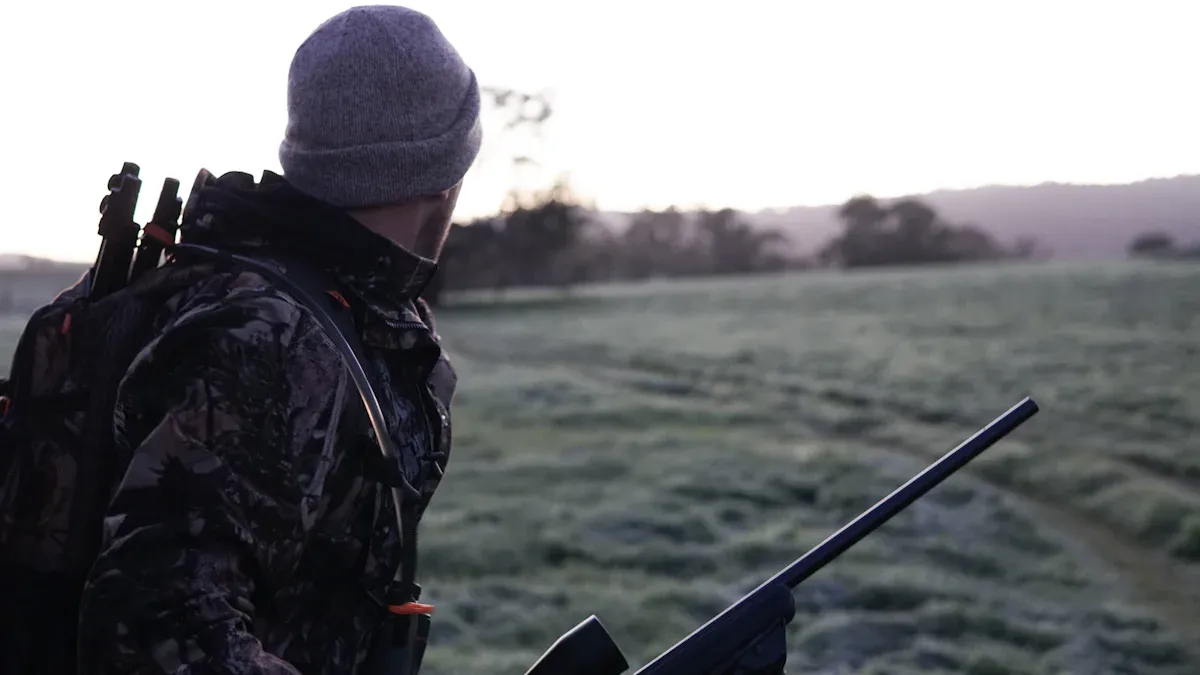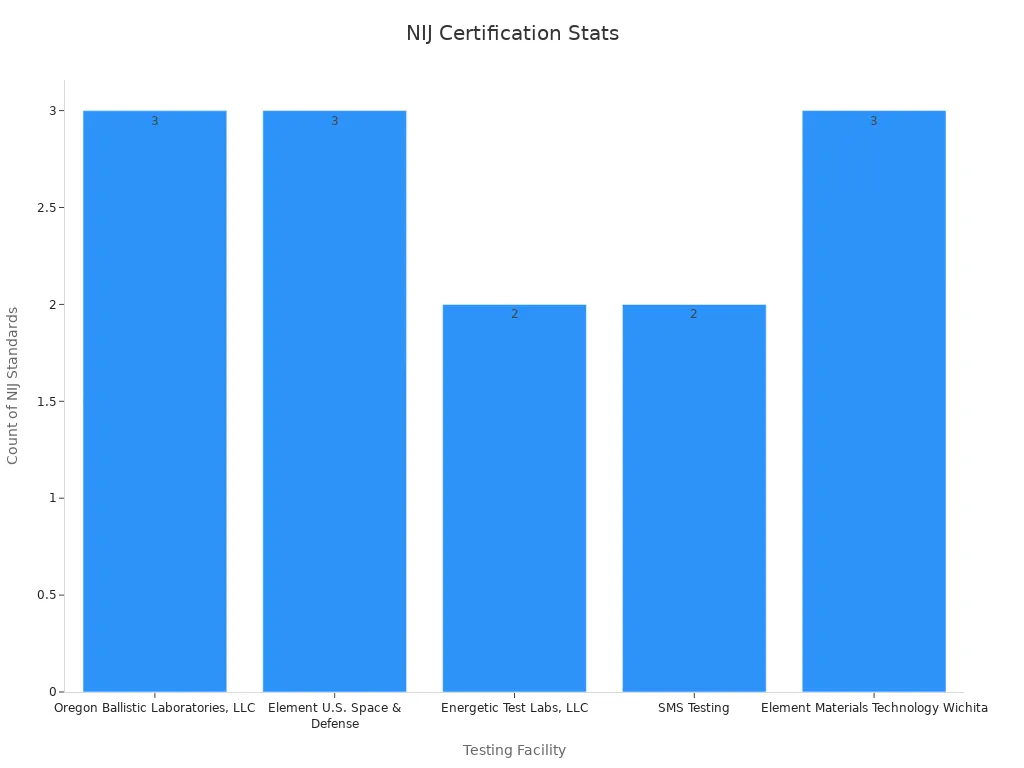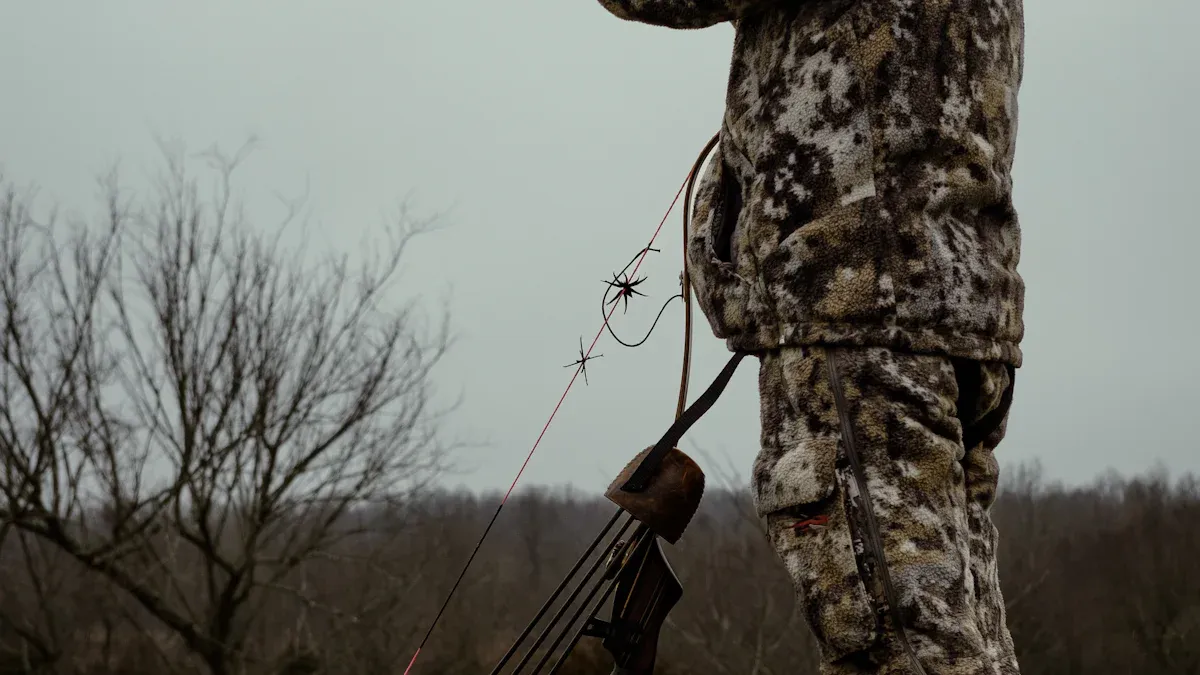How to Pick the Best Hunting Clothing Manufacturer: The Definitive Guide for 2025

📌 Table of Contents
Choosing a good hunting clothing manufacturer is very important. It’s not just about gear—it’s about staying safe and comfy. A reputable manufacturer provides clothes that protect you from bad weather and tough ground. Custom gear from a skilled hunting clothing manufacturer helps you meet the needs of your hunt. Caring about the environment also matters. Manufacturers who use eco-friendly methods earn trust and loyalty. Their reputation and fair prices help you get great gear without spending too much.
Key Takeaways
- Pick hunting clothes made from strong materials like Gore-Tex and wool. These fabrics keep you dry, warm, and comfy while hunting.
- Find makers that let you customize your gear. Custom gear fits well and works for your hunting needs, helping you do better.
- Look for companies that care about the environment. Makers using eco-friendly materials and fair work rules help the planet and workers.
- Check reviews and history of the company. Good companies usually have happy customers and make quality products.
- Match price with quality. Buying strong gear saves money later and keeps you safe and comfy while hunting.
Quality and Durability

Good hunting gear must be strong and last long. It should handle rough ground, bad weather, and long outdoor hours. Let’s see how to check these important things.
Checking Material Quality
The fabric of hunting clothes is very important. It keeps you safe and comfy. Pick materials that are breathable, waterproof, and tough. For instance, Gore-Tex keeps you dry but doesn’t trap heat. Wool is also great—it’s warm, keeps sweat away, and doesn’t smell easily.
Look for extras like strong stitching and tough panels. These help when walking through thick woods or rocky areas. Ask the manufacturer about their fabric tests. Good manufacturers use special tests to make sure their materials are top quality.
Checking How Well It’s Made
Durability isn’t just about fabric. It’s also about how the clothes are made. Check seams, zippers, and closures. Double-stitched seams are stronger and don’t come apart easily. Strong zippers and snaps last longer even with heavy use.
If you can, look at sample products or photos. Check for neat stitching and well-attached parts. Some manufacturers even give warranties, showing they trust their products.
Certifications That Prove Quality
Certifications help prove the quality of hunting clothes. They show the manufacturer follows certain rules. Here are some certifications you might see:
- NIJ (USA): Tests protection from handguns and rifles.
- VPAM (Europe): Checks soft and hard armor under European rules.
- CAST (UK): Tests for knife and bullet threats.
- DEA/FBI Standards (USA): Strict tests for police use.
- STANAG (NATO): Military tests for explosion resistance.
Here’s a table of testing places and their approved standards:
| Testing Facility | Location | Approved Standards |
|---|---|---|
| Oregon Ballistic Laboratories, LLC | Salem, OR | NIJ Standards 0101.06, 0101.07, 0115.00 |
| Element U.S. Space & Defense | Belcamp, MD | NIJ Standards 0101.06, 0101.07, 0115.00 |
| Energetic Test Labs, LLC | Phoenix, AZ | NIJ Standards 0101.06, 0101.07 |
| SMS Testing | Rising Sun, MD | NIJ Standards 0101.06, 0101.07 |
| Element Materials Technology Wichita | Wichita, KS | NIJ Standards 0101.06, 0101.07, 0115.00 |

These certifications show the clothes meet strict rules. Choosing certified products means you can trust your hunting gear.
Customization Options
Why Customization Matters for Hunting
Hunting needs are different for everyone. One size doesn’t fit all. Hunters need gear based on weather, season, and game type. Customization helps match your gear to these needs. For example, summer hunts need light clothes. Winter hunts need warm, insulated layers.
Studies show hunters want more personalized gear. The hunting camo clothing market is growing fast. Men, women, and kids all have different needs. Manufacturers now offer more choices to meet these demands. Custom gear isn’t just comfy—it helps you perform better and stay ready for challenges.
Key Features in Custom Hunting Gear
Not all custom gear is the same. Pick a manufacturer that offers useful features. Look for these important options:
- Adjustable Fit: Elastic cuffs or drawstrings help gear fit well.
- Camouflage Patterns: Choose patterns that match forests or open fields.
- Pockets and Storage: Extra pockets hold tools like knives or ammo.
- Weather Resistance: Waterproof or windproof fabrics keep you dry and warm.
Some companies even add embroidery or logos for a personal touch. These features make your gear both useful and unique.
How to Check a Manufacturer’s Custom Options
To find the right manufacturer, check their customization choices. Look at their website or catalog. Do they offer many sizes, patterns, and features? Photos or videos can show the quality of their work.
Ask questions. Can they add special features like reinforced panels or logos? A good manufacturer listens to your needs and adjusts. Reviews from other hunters can also show how well they deliver on promises.
Tip: Test their work with a small order first. This ensures their quality meets your standards before buying more.
Ethical and Sustainable Practices

When picking a hunting clothing manufacturer, think about their ethics. Ethical and sustainable practices help the planet and treat workers fairly. They also ensure materials are responsibly sourced. Let’s learn how to spot ethical methods, why sustainable materials matter, and which certifications prove these standards.
Spotting Ethical Manufacturing Methods
Ethical manufacturing is more than making clothes. It includes fair worker treatment, less waste, and clear sourcing. Here’s how to find ethical manufacturers:
- Choose companies that reuse materials or design clothes with less waste.
- Check if they share details about where their materials come from. Being open builds trust.
- Certifications like Fair Trade and SA8000 show workers are safe and treated well.
Some brands go further with creative ideas. For example, the WILD Concept uses fur from Finnish hunters who follow strict rules. This avoids farmed fur and ensures animals are not harmed unnecessarily.
Tip: Ask manufacturers about their processes. Ethical ones are happy to explain their efforts.
Why Sustainable Materials Matter
Sustainable materials are better for the planet and still durable. They lower harm to nature while keeping quality high. Did you know making raw materials causes 38% of fashion’s emissions? Picking sustainable options helps reduce this impact.
Look for these materials:
- Recycled Fabrics: Old materials are reused to cut waste.
- Organic Cotton: Grown without harmful chemicals, it’s safer for nature and skin.
- Bamboo: Grows fast, needs little water, and no pesticides.
- Wool: Natural, biodegradable, warm, and keeps sweat away.
These materials are eco-friendly and good for people too. By choosing them, you get great gear and help the environment.
Certifications That Prove Ethics and Sustainability
Certifications help confirm a company’s ethical and green claims. They prove the company meets strict rules. Here are some important certifications:
| Certification Name | Focus Areas | Description |
|---|---|---|
| Forest Stewardship Council (FSC) | Protects forests, helps people, supports economy | Ensures wood and forest products are responsibly sourced worldwide. |
| Green Seal | Environmental care | Approves products that meet tough eco and health standards to cut harm. |
| SA8000 | Fair worker treatment | Focuses on worker safety, no child labor, and no discrimination. |
These certifications help you find manufacturers that care about ethics and sustainability. For example, the WILD Concept uses fur from wild animals, reducing waste and ensuring ethical sourcing.
Note: Always look for certifications when researching manufacturers. They’re a trustworthy way to make responsible choices.
Reputation and Reviews
Checking a Manufacturer’s History
Before picking a hunting clothing manufacturer, learn about their past. A good history shows they are trustworthy. Check how long they’ve been making products. Companies with more experience often make better gear.
See if they’ve won awards or earned recognitions. These show they care about quality. Also, find out if they’ve worked with famous brands or groups. This can prove they are reliable.
Tip: Look at their website or social media. Many companies share their achievements and partnerships there.
Reading Customer Reviews and Feedback
Customer reviews help you understand a manufacturer’s reputation. They show what people think about their products and service. Read reviews on trusted sites like Google or Trustpilot. Look for comments about quality, delivery, and support.
Check testimonials on the company’s website too. These often share happy customer stories. But don’t rely only on these. Compare them with reviews from other websites for a full picture.
Notice patterns in reviews. If many people praise the gear’s strength, that’s a good sign. But if late deliveries are a common complaint, think carefully.
Signs of a Bad Manufacturer
Spotting problems early can save you trouble later. Avoid manufacturers with little online info or unclear contact details. If there are no reviews or feedback, that’s a bad sign.
Be careful if they make big claims without proof. For example, saying their gear is “the best” but showing no certifications. Also, avoid companies with many complaints about bad service or poor quality.
Alert: If a company demands full payment upfront without offering samples, be cautious. Good manufacturers usually have flexible payment options.
Pricing and Value
Balancing Cost with Quality and Features
Finding good hunting gear means balancing cost and quality. You don’t need the priciest gear, especially if you’re new. Expensive clothing has better insulation and lasts longer. But beginners can start with mid-priced options from big stores. These are affordable and still work well.
Spending more on durable gear saves money over time. Strong clothing lasts longer and protects you better. It also makes hunting more enjoyable by keeping you comfy. If you hunt often, paying more upfront can be worth it.
Tip: Think about your hunting style. For tough weather, pick advanced gear. For casual trips, mid-priced options might work fine.
Understanding Pricing Models in Manufacturing
Manufacturers use different ways to price their products. Knowing these helps you choose wisely. Some offer discounts for bigger orders. Buying in bulk can save money. Others keep prices the same no matter the order size.
Adding custom features like stronger panels or special camo costs more. But these extras can make your gear better for hunting.
Here’s a simple table of pricing models:
| Pricing Model | Description | Best For |
|---|---|---|
| Tiered Pricing | Bigger orders get discounts | Bulk purchases |
| Fixed Pricing | Same price for all orders | Small or medium orders |
| Customization Pricing | Extra cost for added features | Personalized hunting gear |
Knowing these models helps you plan your spending and avoid surprises.
Tips for Negotiating with Manufacturers
Talking with manufacturers can help you save money. Start by checking your costs. See where you can cut expenses, like shipping or materials. Manufacturers may lower prices if you give helpful feedback.
Long-term deals can also get you better prices. If you order often, ask for discounts for being a loyal customer. This benefits both sides—you save money, and they keep your business.
Tip: Be clear about what you want. If you need special features, say so early. Manufacturers are more likely to meet your needs when they know your priorities.
Picking the best hunting clothing maker is very important. Focus on key things like quality, custom options, fair practices, reputation, and price. These help you get gear that works well, fits right, and matches your values.
Spend time learning about different companies. Think about what matters most to you, like strong materials, eco-friendly choices, or saving money. Start with a small order to test their products. This lets you check their work before buying more. With careful planning, you’ll find a company that gives you exactly what you need.
FAQ
What should I focus on when picking a hunting clothing maker?
Look for strong, long-lasting gear with custom options. Choose companies with fair practices and good reviews. These help you get gear that works well and matches your values.
How can I tell if a company uses eco-friendly materials?
Ask how they get their materials and check for certifications. Labels like FSC or Green Seal show they care about the planet.
Is spending more on custom hunting gear a good idea?
Yes, if you hunt often or face tough weather. Custom gear fits better, lasts longer, and works well in special conditions. It’s worth the cost for safety and comfort.
How can I find out if a company is reliable?
Read reviews, check their awards, and learn their history. Good companies share their successes and have happy customers. Stay away from companies with bad reviews or unclear details.
Can I ask for lower prices from a manufacturer?
Yes! Many companies give discounts for big orders or repeat buyers. Be clear about what you need and ask for deals.
Ready to elevate your outdoor apparel line?
Let’s talk. We offer flexible MOQ, fast samples, and expert guidance — get your quote today.
You may also be interested in:

A Hunter's Guide to Waterproof & Breathable Fabric Science
Introduction For any serious hunter, the right apparel is not a luxury; it is a critical piece of equipment that

Lowering MOQs: A Guide for Hunting & Outdoor Brands
You’ve done it. After countless late nights, sketches on napkins, and heated debates over fabric textures, you’ve perfected the design

From Prototype to Production: Accelerating Your Hunting Gear Development
You’ve got a killer idea for a piece of hunting gear. A jacket that’s lighter, a pack that’s smarter, a
